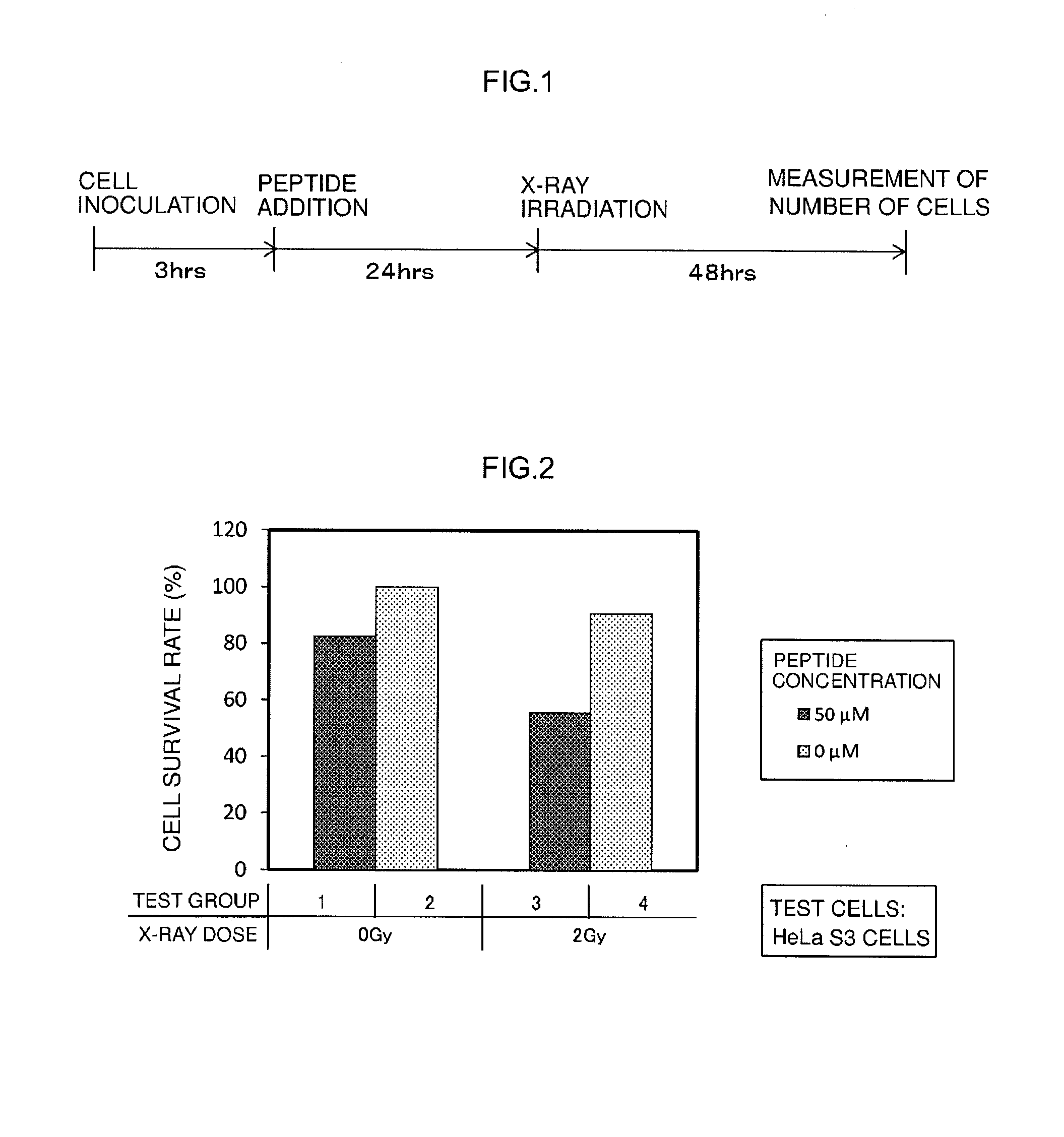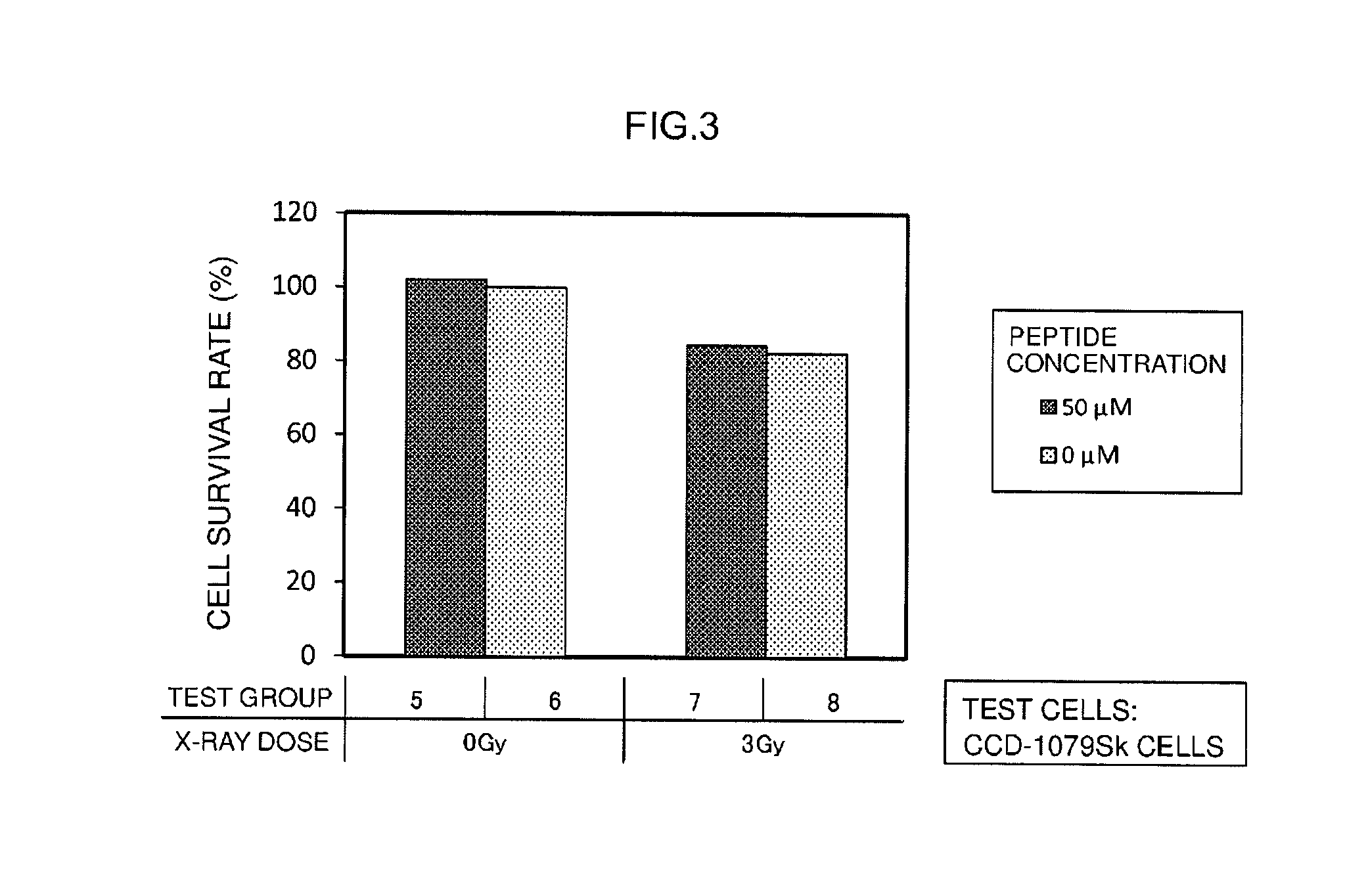Synthetic peptide that increases radiosensitivity of tumor cells and use of same
a peptide and radiosensitivity technology, applied in the direction of peptide/protein ingredients, drug compositions, x-ray/gamma-ray/particle irradiation therapy, etc., can solve the problems of difficult irradiation of target cells, inability to adequately obtain the therapeutic effect of radiation therapy, etc., to achieve effective tumor treatment, increase the radiosensitivity of tumor cells constituting the tumor, and efficiently kill the
- Summary
- Abstract
- Description
- Claims
- Application Information
AI Technical Summary
Benefits of technology
Problems solved by technology
Method used
Image
Examples
example 1
Peptide Synthesis
[0129]A radiosensitizing synthetic peptide in the form of a peptide constituted of the radiosensitizing peptide sequence of CKSKSRRSC (SEQ ID NO. 1) was synthesized by solid-phase synthesis (Fmoc method) according to the manual using a commercially available peptide synthesizer (Intavis AG). A linear synthetic peptide constituted of a total of nine amino acid residues was named “Sample 1”. Furthermore, since the manner of use per se of the peptide synthesizer does not characterize the present invention, a detailed explanation thereof is omitted. The synthesized Sample 1 was dissolved in PBS(−) to prepare a peptide stock solution.
example 2
Evaluation Test of Radiosensitizing Activity of Synthetic Peptide
[0130]Radiosensitizing activity of the radiosensitizing synthetic peptide (Sample 1) obtained in Example 1 was evaluated by measuring cell survival rates during culturing after having irradiated test cells supplied with the radiosensitizing synthetic peptide with radiation (here, X-rays).
[0131]Human carcinoma-derived cells (HeLaS3 cells) and cells derived from normal human tissue (CCD-1079Sk cells) were used for the test cells. As shown in Table 1, each of the test cells were cultured while changing the peptide concentration in the medium and the radiation dose followed by measurement of cell survival rates. Furthermore, a time chart of cell culturing in this evaluation test is shown in FIG. 1. Details of the evaluation test are as indicated below.
TABLE 1Test GroupTest CellsPeptide ConcentrationX-ray Dose1HeLaS350 μM0 Gy2 0 μM350 μM2 Gy4 0 μM5CCD-1079Sk50 μM0 Gy6 0 μM750 μM3 Gy8 0 μM
[0132]First, a cultured cell line de...
example 3
Evaluation Test of Radiosensitizing Activity of Synthetic Peptide on Tumor Tissue
[0153]Furthermore, although the detailed test procedure and results are not indicated here, the radiosensitizing activity of the radiosensitizing synthetic peptide (Sample 1) obtained in Example 1 was evaluated by targeting tumor tissue removed from the body. As a result, tumor tissue that supplied with the peptide, irradiated with X-rays and then cultured for a prescribed amount of time exhibited a remarkable decrease in tumor tissue volume in comparison with tumor tissue to which the peptide was not added or not irradiated with X-rays. Namely, administration of radiosensitizing synthetic peptide disclosed herein (namely, a pharmaceutical composition containing the peptide) to a patient followed by irradiating the tumor tissue with X-rays was confirmed to be able to realize effective tumor treatment.
PUM
| Property | Measurement | Unit |
|---|---|---|
| Fraction | aaaaa | aaaaa |
| Solar gamma radiation | aaaaa | aaaaa |
| Solar gamma radiation | aaaaa | aaaaa |
Abstract
Description
Claims
Application Information
 Login to View More
Login to View More - R&D
- Intellectual Property
- Life Sciences
- Materials
- Tech Scout
- Unparalleled Data Quality
- Higher Quality Content
- 60% Fewer Hallucinations
Browse by: Latest US Patents, China's latest patents, Technical Efficacy Thesaurus, Application Domain, Technology Topic, Popular Technical Reports.
© 2025 PatSnap. All rights reserved.Legal|Privacy policy|Modern Slavery Act Transparency Statement|Sitemap|About US| Contact US: help@patsnap.com


